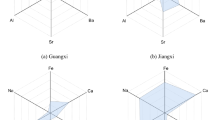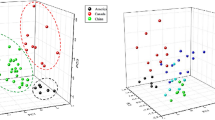Abstract
Traceability offers significant information about the quality and safety of Chinese Angelica, a medicine and food homologous substance. In this study, a systematic four-step strategy, including sample collection, specific metal element fingerprinting, multivariate statistical analysis, and benefit-risk assessment, was developed for the first time to identify Chinese Angelica based on geographical origins. Fifteen metals in fifty-six Chinese Angelica samples originated from three provinces were analyzed. The multivariate statistical analysis model established, involving hierarchical cluster analysis (HCA), principal component analysis (PCA), and self-organizing map clustering analysis was able to identify the origins of samples. Furthermore, benefit-risk assessment models were created by combinational calculation of chemical daily intake (CDI), hazard index (HI), and cancer risk (CR) levels to evaluate the potential risks of Chinese Angelica using as traditional Chinese medicine (TCM) and food, respectively. Our systematic strategy was well convinced to accurately and effectively differentiate Chinese Angelica based on geographical origins.







Similar content being viewed by others
Abbreviations
- TCMs:
-
Traditional Chinese medicines
- MFHS:
-
Medicine and food homologous substance
- ICP-MS:
-
Inductively coupled plasma mass spectrometry
- PPRC:
-
Pharmacopoeia of the People’s Republic of China
- SMEF:
-
Specific metal element fingerprinting
- HCA:
-
Hierarchical cluster analysis (HCA)
- PCA:
-
Principal component analysis
- CDI:
-
Chemical daily intake
- HI:
-
Hazard index
- CR:
-
Lifetime cancer risk
- CSF:
-
Cancer slope factor
References
AlmeidaL JAS, Barbosa MS, Pais AACC, Formosinho SJ (2007) Improving hierarchical cluster analysis: a new method with outlier detection and automatic clustering. Chemom Intell Lab Syst 87(2):208–217
Anderson KA, Smith BW (2002) Chemical profiling to differentiate geographic growing origins of coffee. J Agric Food Chem 50(7):2068–2075
Barakat MA (2011) New trends in removing heavy metals from industrial wastewater. Arab J Chem 4:361–377
Bellinger DC (2008) Very low lead exposures and children’s neurodevelopment. Curr Opin Pediatr 20:172–177
Cao HB, Qiao L, Zhang H (2010) Exposure and risk assessment for aluminum and heavy metals in Puerh tea. Sci Total Environ 408(14):2777–2784
Cao L, Du J, Ding W, Rui J, Yin G (2014) Hepatoprotective and antioxidant effects of dietary Angelica sinensis extract against carbon tetrachloride-induced hepatic injury in Jian Carp (Cyprinus carpio var. Jian). Aquac Res 47:1852–1863
Cherfi A, Abdoun S, Gaci O (2014) Food survey: levels and potential health risks of chromium, lead, zinc and copper content in fruits and vegetables consumed in Algeria. Food Chem Toxicol 70(5):48–53
Coetzee PP, Steffens FE, Eiselen RJ, Augustyn OP, Balcaen L, Vanhaecke F (2005) Multi-element analysisof south African wines by ICP-MS and their classification according to geographical origin. J Agric Food Chem 53:5060–5066
Di Bella G, Lo Turco V, Potortί AG, Bua GD, Fede MR, Dugo GM (2015a) Geographical discrimination of Italian honey by multi-element analysis with a chemometric approach. J Food Compos Anal 44:25–35
Di Bella G, Potorti AG, Lo Turco V, Bua D, Licata P, Cicero N, Dugo G (2015b) Trace elements in Thunnus thynnus from Mediterranean sea: benefit-risk assessment for consumers. J Food Additiv Contam B Surveil 8(3):175–181
Emenike PC, Omole DO, Ngene BU, Tenebe IT (2016) Potentiality of agricultural adsorbent for the sequestering of metal ions from wastewater. Global J Environ Sci Manag 2:411–442
Fallahzadeh RA, Ghaneian MT, Miri M, Dashti MM (2017) Spatial analysis and health risk assessment of heavy metals concentration in drinking water resources. Environ Sci Pollut Res 24(32):24790–24802
Frost-Meyer NJ, Logomarsino JV (2012) Impact of coffee components on inflammatory markers: a review. J Funct Foods 4(4):819–830
Ghee C, Hallett P, Neilson R, Robinson D, Paterson E (2013) Carbon dynamics of contrasting agricultural practices. EGU General Assembly 102(4):161–178
Granatoa D, Santos JS, Escher GB, Ferreira BL, Maggio RM (2018) Use of principal component analysis (PCA) and hierarchical cluster analysis (HCA) for multivariate association between bioactive compounds and functional properties in foods: a critical perspective. Trends Food Sci Technol 72:83–90
Grembecka M, Malinowska E, Szefer P (2007) Differentiation of market coffee and its infusions in view of their mineral composition. Sci Total Environ 383(1):59–69
Heaton K, Kelly SD, Hoogewerff J, Woolfe M (2008) Verifying the geographical origin of beef: the application of multi-element isotope and trace element analysis. Food Chem 107(1):506–515
Huang J, Shimizu H, Shioya S (2003) Clustering gene expression pattern and extracting relationship in gene network based on artificial neural networks. J Biosci Bioeng 96(5):421–428
Hughes MF (2002) Arsenic toxicity and potential mechanisms of action. Toxicol Lett 133:1–16
IRIS, Integrated Risk Information System. Available at https://www.epa.gov/research/integrated-risk-informationsystem-iris-current-assessments-and-recentdevelopments-0, 2012
Jaishankar M, Tseten T, Anbalagan N, Mathew BB, Beeregowda KN (2014) Toxicity, mechanism and health effects of some heavy metals. Interdiscip Toxicicol 7:60–72
Järup L (2003) Hazards of heavy metal contamination. Br Med Bull 68(1):167–182
Khan S, Cao Q, Zheng YM, Huang YZ, Zhu YG (2008) Health risks of heavy metals in contaminated soil and food crops irrigated with wastewater in Beijing, China. Environ Pollut 152(3):686–692
Kment P, Mihaljevic M, Ettler V, Sebek O, Strnard L, Rohlová L (2005) Differentiation of Czech wines using multielement composition—a comparison with vineyard soil. Food Chem 91:157–165
Krejpcio Z, Sionkowski S, Bartela J (2005) Safety of fresh fruits and juices available on the Polish market as determined by heavy metal residues. Pol J Environ Stud 14(6):877–881
Li A, Han L, Han CC (2012) Antioxidant and neuroprotective activities of essential oil, isolated from Chinese herb pairs of Angelica sinensis and Sophora flavescens. J Appl Pharm Sci 2:1–4
Lifschitz D, Sternberg M, Bonfil D, Bendor E, Eshel G (2010) The effect of cultivation practices on soil-atmosphere carbon cycle under arid climate conditions. EGU Generbl Assembly 2:9465–9466
Lin CS, Fan CY, Fan PS, Wang YW (2010) Hybrid self-organizing map and neural network clustering analysis for technology professionals turnover rate forecasting. International Conference on Intelligent Computing 2010, 93, 178–185
Lin Z, Gu J, Xiu J, Mi T, Dong J, Tiwari JK (2011) Traditional Chinese medicine for senile dementia. Evid-Based Complement Alternat Med 2012:1–13
Lin X, Sha LJ, Lan SS, Lin T, Wei MQ, He LZ, Liu HC (2015) Application of chemical metrology software of Pu-erh tea geographical origin traceability. J Food Saf Qual 9:354–361
Ma G, Zhang Y, Zhang J, Wang G, Chen L, Zhang M, Liu T, Liu X, Lu C (2016) Determining the geographical origin of Chinese green tea by linear discriminant analysis of trace metals and rare earth elements: taking Dongting Biluochun as an example. Food Control 59:714–720
Mahmood A, Malik RN (2013) Human health risk assessment of heavy metals via consumption of contaminated vegetables collected from different irrigation sources in Lahore. Arab J Chem 7(1):91–99
Oliveira M, Ramos S, Delerue-Matos C, Morais S (2015) Espresso beverages of pure origin coffee: mineral characterization, contribution for mineral intake and geographical discrimination. Food Chem 177:330–338
Ozaki Y (1992) Antiinflammatory effects of tetramethylpyrazine and ferulic acid. Chem Pharm Bull 40:954–956
Profeta A, Balling R, Schoene V, Wirsig A (2010) Protected geographical indications and designations of origin: an overview of the status quo and the development of the use of regulation (EC) 510/06 in Europe, with special consideration of the German situation. J Int Food Agribus Market 22(1–2):179–198
Roba C, Roşu C, Piştea I, Ozunu A, Baciu C (2016) Heavy metal content in vegetables and fruits cultivated in Baia Mare mining area (Romania) and health risk assessment. Environ Sci Pollut Res 23(7):6062–6073
Sanders AP, Claus Henn B, Wright RO (2015) Perinatal and childhood exposure to cadmium, manganese, and metal mixtures and effects on cognition and behavior: a review of recent literature. Current Environ Health Rep 2:84–294
Santamaria AB, Sulsky SI (2010) Risk assessment of an essential element: manganese. J Toxicol Environ Health- A 73(2):128–155
Santato A, Bertoldi D, Perini M, Camin F, Larcher R (2012) Using elemental profiles and stable isotopes to trace the origin of green coffee beans on the global market. J Mass Spectrom 47(9):1132–1140
Shen HM, Zhang QF (1994) Risk assessment of nickel carcinogenicity and occupational lung cancer. Environ Health Perspect 102(Suppl 1):275–282
Singh A, Sharma RK, Agrawal M, Marshall FM (2010) Health risk assessment of heavy metals via dietary intake of foodstuffs from the wastewater irrigated site of a dry tropical area of India. Food Chem Toxicol 48(2):611–619
Sirot V, Guérin T, Volatier JL, Leblanc JC (2009) Dietary exposure and biomarkers of arsenic in consumers of fish and shellfish from France. Sci Total Environ 407(6):1875–1885
Sofuoglu SC, Kavcar P (2008) An exposure and risk assessment for fluoride and trace metals in black tea. J Hazard Mater 158(2–3):392–400
The Pharmacopoeia Commission of the People's Republic of China (2015 Edition). 2015. Beijing, China: Pharmacopoeia of the People's Republic of China, Chinese Medical Science and Technology Publishers
Zang XD, Huang HSY, Zhuang ZL, Chen RS, Xie ZY, Xu C, Mo XM (2018) The association between serum copper concentrations and cardiovascular disease risk factors in children and adolescents in NHANES. Environ Sci Pollut Res 25:16951–16958
Zhang WL, Du Y, Zhai MM, Shang Q (2014) Cadmium exposure and its health effects: a 19-year follow-up study of a polluted area in China. Sci Total Environ 470:224–228
Zhou J, Liang J, Hu YM, Zhang WT, Liu HL, You LY, Zhang WH, Gao M, Zhou J (2018) Exposure risk of local residents to copper near the largest flash copper smelter in China. Sci Total Environ 630:453–461
Zukowska J, Biziuk M (2010) Methodological evaluation of method for dietary heavy metal intake. J Food Sci 73:21–29
Zuo TT, Li YL, Jin HY, Gao F, Wang Q, Wang YD, Ma SC (2018) HPLC–ICP–MS speciation analysis and risk assessment of arsenic in Cordyceps sinensis. Chin Med 13:19–28
Acknowledgments
This study was supported by the National Major Scientific and Technological Special Project for “Significant New Drugs Development” (2018ZX09735006).
Author information
Authors and Affiliations
Contributions
SCM and LS designed the study. LS, TTZ, CJF, and XDL conducted the experiments. TTZ analyzed the data. LS wrote the manuscript. XM, TTZ, SCW, SCM, HYJ, LS revised the manuscript. All authors read and approved the final manuscript.
Corresponding authors
Ethics declarations
Availability of data and materials
All data are fully available without restriction.
Competing interests
The authors declare that they have no competing interests.
Additional information
Responsible editor: Philippe Garrigues
Publisher’s note
Springer Nature remains neutral with regard to jurisdictional claims in published maps and institutional affiliations.
Highlights
• A systematic four-step strategy discriminating Chinese Angelica origins was developed.
• The multivariate statistical analysis model was able to identify the geographical origins.
• Risk assessment models evaluated the potential risks of Chinese Angelica used as both TCM and food.
Rights and permissions
About this article
Cite this article
Sun, L., Ma, X., Jin, HY. et al. Geographical origin differentiation of Chinese Angelica by specific metal element fingerprinting and risk assessment. Environ Sci Pollut Res 27, 45018–45030 (2020). https://doi.org/10.1007/s11356-020-10309-x
Received:
Accepted:
Published:
Issue Date:
DOI: https://doi.org/10.1007/s11356-020-10309-x




